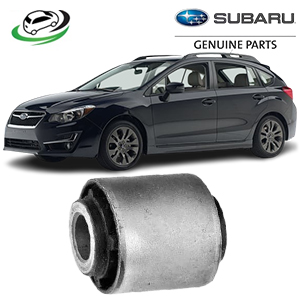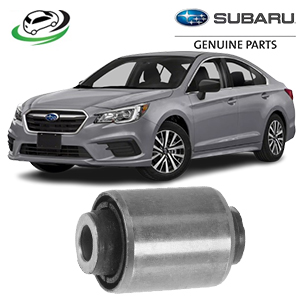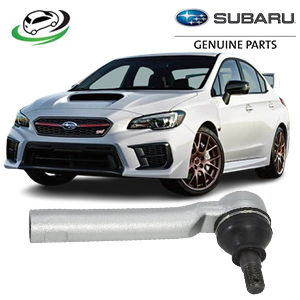-10%
Get Subaru STI 2018 Steering Tie Rod End 34161SA001
The steering tie rod end is a crucial component of a vehicle’s steering system, linking the steering rack to the steering knuckle and allowing the driver to steer the vehicle effectively. In this comprehensive overview, we will explore the functions, structure, benefits, signs of wear, and maintenance of tie rod ends, as well as their importance in vehicle handling and safety.
1. What is a Steering Tie Rod End?
A steering tie rod end is a joint that connects the tie rod to the steering knuckle, facilitating the transfer of steering input from the driver to the wheels. It is part of the steering linkage system and plays a significant role in steering control and alignment.
Structure and Composition
- Tie Rod: This is the long metal rod that connects the steering rack (or gear) to the steering knuckle. The tie rod is usually composed of high-strength steel to withstand the forces exerted during steering.
- Tie Rod End: The tie rod end consists of a ball joint housed in a metal casing, usually made from forged steel. The ball joint allows for a wide range of motion while maintaining a secure connection to the steering knuckle.
- Boot: A rubber or plastic boot surrounds the tie rod end to protect it from dirt, debris, and moisture, which can lead to premature wear.
2. Functions of a Steering Tie Rod End
The primary functions of a steering tie rod end are essential for ensuring proper vehicle handling and control.
a. Steering Control
The tie rod end is critical for transferring the driver’s steering input from the steering wheel to the wheels. When the driver turns the steering wheel, the motion is transmitted through the steering column and steering gear to the tie rod, which then pivots the tie rod ends and steers the wheels in the desired direction.
b. Alignment and Stability
The tie rod end plays a vital role in maintaining proper wheel alignment. It helps ensure that the front wheels are correctly positioned relative to the vehicle’s chassis, providing stability and reducing tire wear. Proper alignment is essential for safe handling and predictable steering response.
c. Absorbing Impact
As the vehicle encounters bumps and uneven road surfaces, the tie rod end allows for slight movements of the steering knuckle. This flexibility helps absorb shocks and impacts, providing a smoother ride and reducing stress on the steering components.
d. Facilitating Suspension Movement
The tie rod end also accommodates the suspension’s up-and-down movement. As the wheels travel over bumps, the tie rod end allows for vertical movement while maintaining the steering connection, enabling the suspension system to function effectively.
3. Benefits of a Properly Functioning Steering Tie Rod End
When the steering tie rod end is in good condition, it provides numerous benefits that enhance vehicle performance and driver experience.
a. Improved Steering Responsiveness
A well-functioning tie rod end ensures that the steering system operates smoothly and accurately. This translates into improved steering responsiveness, allowing the driver to maneuver the vehicle effectively and confidently.
b. Enhanced Vehicle Stability
Properly aligned tie rod ends contribute to overall vehicle stability. When the wheels are correctly aligned, the vehicle handles better during cornering and braking, reducing the risk of loss of control.
c. Reduced Tire Wear
Worn or misaligned tie rod ends can lead to uneven tire wear. By maintaining proper alignment, functioning tie rod ends help extend tire life and reduce the frequency of replacements, saving money in the long run.
d. Increased Safety
A reliable steering tie rod end is essential for safe driving. Proper steering response and stability reduce the risk of accidents caused by steering failures or misalignment. A well-maintained steering system is critical for the overall safety of the vehicle.
e. Improved Ride Quality
By absorbing shocks and impacts, the tie rod end contributes to a smoother ride. This enhances the comfort of both the driver and passengers, making for a more enjoyable driving experience.
4. Signs of a Failing Steering Tie Rod End
Over time, tie rod ends can wear out due to exposure to road conditions, dirt, and moisture. Recognizing the signs of a failing tie rod end is crucial for maintaining vehicle safety and performance.
a. Uneven Tire Wear
If you notice uneven wear patterns on your tires, this may indicate a problem with the tie rod ends or other suspension components. Misalignment caused by worn tie rod ends can lead to excessive tire wear, requiring more frequent replacements.
b. Loose or Wandering Steering
A loose or wandering steering feel can be a sign of a failing tie rod end. If the steering feels imprecise or if the vehicle drifts to one side, it may indicate that the tie rod end is worn and not maintaining proper alignment.
c. Clunking or Popping Noises
If you hear clunking or popping noises while turning or driving over bumps, this could indicate that the tie rod end is loose or damaged. These sounds often signal that the ball joint within the tie rod end is failing.
d. Vibration in the Steering Wheel
Excessive vibration in the steering wheel, especially during acceleration or when driving over rough terrain, may indicate that the tie rod end is worn. The vibrations can affect driving comfort and indicate potential steering issues.
e. Steering Play
Excessive play in the steering wheel can signal worn tie rod ends. If the steering wheel has a lot of movement without corresponding wheel movement, this could indicate that the tie rod end is loose or damaged.
5. Maintenance of Steering Tie Rod Ends
Regular maintenance and timely replacement of steering tie rod ends are essential for ensuring optimal vehicle performance and safety. Here are several key tips for maintaining these components:
a. Routine Inspections
Include tie rod ends in your regular vehicle inspections. Check for signs of wear, such as cracking, tearing of the boot, or looseness in the joint. If any issues are detected, replacement is necessary.
b. Monitor for Unusual Noises and Handling
Stay alert for any unusual noises or changes in steering feel. If you hear clunking or experience steering play, have the tie rod ends inspected immediately.
c. Keep the Boot Intact
The boot that covers the tie rod end is essential for protecting the joint from dirt and moisture. Inspect the boot regularly for cracks or tears and replace it if damaged to prevent contamination of the joint.
d. Align the Wheels
Regular wheel alignments are crucial for ensuring that the tie rod ends function properly. Misalignment can lead to premature wear and affect overall vehicle handling. Follow the manufacturer’s recommendations for alignment intervals.
e. Replace Worn Tie Rod Ends Promptly
If you notice signs of wear or damage, replace the tie rod ends as soon as possible. Driving with worn or damaged tie rod ends can lead to further damage to the steering and suspension systems, as well as compromise vehicle safety.
6. Steps to Replace Steering Tie Rod Ends
Replacing steering tie rod ends is a task that can typically be accomplished with basic tools and mechanical knowledge. Here’s a general guide on how to replace them:
1. Gather Necessary Tools
You’ll need basic tools such as a socket set, wrench, jack, jack stands, and a tie rod end puller or hammer. Some vehicles may require specific tools, so consult your service manual.
2. Raise the Vehicle
Use a jack to lift the vehicle and secure it on jack stands. This will provide access to the tie rod ends.
3. Remove the Wheel
Take off the wheel on the side where you are replacing the tie rod end to access the steering components.
4. Identify the Tie Rod End
Locate the tie rod end connected to the steering knuckle and the tie rod. It’s typically secured by a nut that holds the ball joint in place.
5. Remove the Tie Rod End
Loosen and remove the nut securing the tie rod end to the steering knuckle. Use a tie rod end puller or a hammer to separate the tie rod end from the knuckle. Be cautious not to damage surrounding components.
6. Unscrew the Old Tie Rod End
With the tie rod end disconnected, unscrew it from the tie rod. Count the number of turns it takes to remove the old tie rod end, as this will help you install the new one in the same position.
7. Install the New Tie Rod End
Screw the new tie rod end onto the tie rod, making sure to use the same number of turns as the old one. This helps maintain alignment.
8. Reattach the Tie Rod End
Position the new tie rod end into the steering knuckle and secure it with the nut. Tighten the nut to the manufacturer’s specifications.
9. Reinstall the Wheel
Put the wheel back on and tighten the lug nuts to the specified torque.
10. Lower the Vehicle
Carefully lower the vehicle back to the ground.
11. Test Drive the Vehicle
After replacing the tie rod end, take the vehicle for a test drive to ensure that steering is smooth and responsive. Monitor for any unusual noises or handling characteristics.
Conclusion
The steering tie rod end is an integral component of a vehicle’s steering system, essential for ensuring proper handling, alignment, and overall vehicle performance. By facilitating the transfer of steering input and maintaining stability, tie rod ends contribute significantly to safe and comfortable driving experiences. Regular inspection, maintenance, and timely replacement of worn tie rod ends are vital for optimizing vehicle performance and ensuring driver safety. Recognizing the signs of wear and addressing issues promptly will help extend the life of the steering components and improve overall vehicle functionality.
Follow us on Facebook for more parts.




Reviews
Clear filtersThere are no reviews yet.